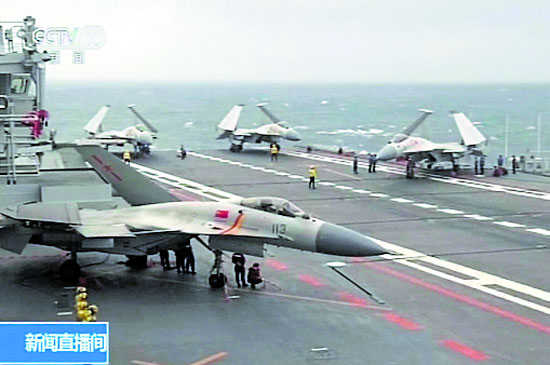
MIC's rising profile: China’s J-15 fighter jets. AP/PTI(image taken from China's CCTV)
Bhartendu Kumar Singh
Indian Defence Accounts Service
When China sent its first domestically produced aircraft carrier for maiden sea trials recently, it joined a select group of countries capable of domestic production, maintenance and operation of aircraft carriers. Glorious moments notwithstanding, China's domestic military-industrial complex (MIC) has successfully achieved a 'great leap forward' in all segments of weapon production, turning the once front-ranking weapons importer into a lead exporter. In the process, it has emerged as the mainstay of China's military power projection.
Till early nineties, China's domestic MIC was in shambles, both in quantitative and qualitative terms. It was producing vintage aircraft, tanks and other armory that were inferior to products available in the international arms market. There were simply too many men producing too little things in the archival MIC. China's weapons requirement was primarily met through imports from Russia and other sources. The budgetary support was limited and the MIC units were making ends meet through conversion of defence technology for civilian use and commercial entrepreneurship. The MIC's poor state of affairs was one of many reasons in China's mid-nineties strategic retreat in the Taiwan Straits.
Rise of China’s military might
Techno-nationalism: The US advances in Revolution in Military Advances (RMA), evident in the Gulf War of 1991, provided the necessary impetus for China's MIC reforms and modernisation. Since then, China has used various tactics to consolidate, strengthen and expand its MIC. Apart from liberal budgetary allocation, China resorted to reverse-engineering and technology-thefts, wherever possible. Techno-nationalism was the driving force enabling China to develop, and in due course, lead in innovation, diffusion and proliferation of defence technology and research and development (R&D) in expanding MIC. The shipbuilding industry, perhaps, best exemplifies cataclysmic advances made by MIC. China has been producing the largest number of ocean-going tankers and big ships for quite some time. This also explains how China's second aircraft carrier, built indigenously, sprang up so fast!
From importer to exporter of weapons: Chinese MIC's rising profile is evident in China's role reversal in the international weapons market. A decade back, China was the world's largest arms importer. However, as per the latest SIPRI figures, China was the fifth largest arms exporter in 2013-17, accounting for 6 per cent of the global sales. Its arms exports rose by 38 per cent between 2008-12 and 2013-17. China exports weapons to 55 countries worldwide, covering Asia, West Asia and Latin America, and many of its clients are developing countries. South Asian neighbours of India (except Bhutan) heavily depend upon Chinese weapons supplies. Though Chinese arms companies are not covered by the SIPRI Fact Sheet (December 2017) on top 100 arms producing and military services companies due to lack of data; based on military spending, China's arms sales and limited information on individual companies, at least 9 to 10 companies would almost certainly be in the top 100 if figures for arms sales were available. Of these, four to six would probably be in the top 20; and two (the aircraft producer AVIC and the land systems producer NORINCO) may be in the top 10.
Most importantly, Chinese exports are shifting from low-end weapons to increasingly advanced ones. For example, China has one of the best fourth generation fighter jets in J-20 and developing countries that can't afford to buy fifth generation aircraft from the US etc, won't mind settling for the same. Similarly, China has inducted Y-20, the heavy transport aircraft, into its PLA Air Force in 2016 and is ideal for transporting cargo and people over long distances in diverse weather conditions.
China's MIC advances are being noticed in the US and elsewhere. Annual reports by the US Department of Defence on Chinese military power include dedicated segments in Chinese advances in weapons production. Additionally, the US China Commission (USCC) takes authoritative updates from various sources about the narrowing gap between the US and Chinese military scorecards. For example, on May 12 this year, the USCC heard from the Jane's (reputed publishers on defence matters) on China's advanced weapons systems. The core hypothesis of the 250-page document, ie about the US lead being eroded, is alarming for Pentagon since Chinese advances may have a potentially disruptive impact on global security.
Plan to be world leader
China's domestic MIC maturity and its consequential rise notwithstanding, Beijing is aware that 'technological parity' with the US is a distant milestone. This has compelled China to design a strategic plan to overtake the US. The 13th five-year science and technology plan, announced in 2016, along with 'make in China plan 2025'are focussed on production of front-end defence technology and weapons. In March 2017, China declassified some 3,000 defence patents for civilian use. In October 2017, President Xi Jinping announced in the 19th Party Congress grandiose plans to enter the first tier of most innovative countries by 2035 and establish leadership by 2050. China is fast developing the necessary infrastructure to achieve these milestones.
1 First, as David Shambaugh in his book (China's Future, Polity Press, 2016) notes, China is investing 2.1 per cent of its GDP in R&D. A substantial portion of this would fund defence R&D. Even with the current investment trajectory, Shambaugh feels that China would overtake US investment figures by 2022.
2 China has 52 per cent of university students graduating in science and technology every year. This talent pool would enhance research in MIC.
3 China has the best model of civil-military integration on dual use of technology, unlike other countries where the two are often in competition and conflict.
4 As the second largest economy, with a complete integration with the global market, China could pillion-ride on front-end technology available at competitive rates elsewhere for defence purposes.
The emergence of a powerful and innovative MIC in China is influencing Chinese behavioural outcome towards its neighbours and great powers. China is supplying weapons at competitive rates and playing alliance and coalition-building exercises. Chinese advances in MIC, therefore, need to be studied carefully for iterating the lessons and a calibrated response.
Views are personal



























